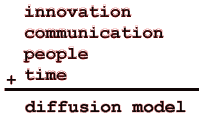Introduction - Java: One Year Out
|
|
Introduction In May 1995, Sun Microsystems officially introduced their new programming language, Java. The company described their product as a perfect tool for building applications to be used in a "heterogeneous, networked, distributed environment." [1] This environment is the World Wide Web. Java applications can be used both on and off the Web. However, the Web represents the extreme in network computing and therefore the benchmark against which to measure Java applications.The Java White Paper explains in great detail how the language's design and implementation fits the internetworked computing model. A year later, however, no significant applications programmed in Java have been tested on the Web. While much industry hype has surrounded Java, the majority of its executables remain either demo applets by the beginning Java programmer or interactive graphics spicing up a Web page. Despite the lack of application development, Java's release is leading a shift in the computing industry away from the centralized personal computing model to the decentralized network computing model. Since Java's release, a flurry of press releases, product announcements, and corporate alliances from industry change-agents such as Sun Microsystems, Netscape Communications Corporation, Oracle Corporation, and Microsoft highlight the struggle for the lead position in this fast-changing environment. Without definite pointers to Java development, how can this shift be measured? Without overwhelming Java applications how can this shift occur?
Everett M. Rogers, the leading theorist in the diffusion of innovations, outlines a model in which it is possible to examine an innovation's diffusion process. Specifically, "diffusion is the process by which an innovation is communicated through certain channels over time among members of a social system." [2] Using this diffusion theory framework, Java will be defined as an innovation which is being diffused through various communication channels in a social system. This transmission takes various paths between individuals; these are the communication channels. These channels are outlined in further detail in section 3, The Model. Briefly, these channels use both mass media and interpersonal forms of communication. A social system is the group receiving and disseminating information about the innovation. System members vary in level of influence and contain both innovation adopters and rejectors. This study considers all Web users as part of the innovation's social system. The framework outlined above allows for the examination of Java's underlying concepts which both mark it as an innovation and point to reasons for this shift. This framework also illustrates the social system in which Java is being diffused and how this system communicates. These two factors, the social system embracing the innovation and the ways in which this system communicates, are the major influences in this industry shift. The following sections of this document (1) describe Java in the context of its social system, (2) present an in-depth examination of Rogers' diffusion theory components and their relation to Java, and through the discussion, (3) give some insight into Java as an innovation today. In particular, this paper seeks answers to the questions: Which aspects of diffusion theory point to Java as a successful innovation in the World Wide Web? Which aspects suggest areas in which the language may fail to achieve adoption? These questions encompass the research issues concerning the current rate of Java adoption, early indicators of Java's ultimate acceptance, and of Java's ultimate application. Using Rogers' diffusion theory and measures taken from both the social system and the communication channels, this paper will identify the ways in which Java is changing an industry computing standard begun by the IBM PC and maintained through Microsoft software. The consequences of this innovation indicate a decentralized network environment which quickens the rate of industry change, the amount of communication, and the quantity of resources.
Comments are welcome Copyright © 1996 Bridget W. Regan and |


 Diffusion studies analyze either the spread of knowledge or how that knowledge leads to use or adoption. This study is concerned with the latter and analyzes how knowledge leads to applications of the innovation. In diffusion research, the transmitted information must contain a new idea or a new way of managing existing technologies for it to be an innovation. The innovation, therefore, is primary in diffusion research. An innovation's perceived attributes can affect not only the rate of adoption, but whether the new idea is adopted at all. Innovation analysis remains one of the most "important research questions addressed by diffusion scholars."
Diffusion studies analyze either the spread of knowledge or how that knowledge leads to use or adoption. This study is concerned with the latter and analyzes how knowledge leads to applications of the innovation. In diffusion research, the transmitted information must contain a new idea or a new way of managing existing technologies for it to be an innovation. The innovation, therefore, is primary in diffusion research. An innovation's perceived attributes can affect not only the rate of adoption, but whether the new idea is adopted at all. Innovation analysis remains one of the most "important research questions addressed by diffusion scholars."  Find a programming school near you
Find a programming school near you